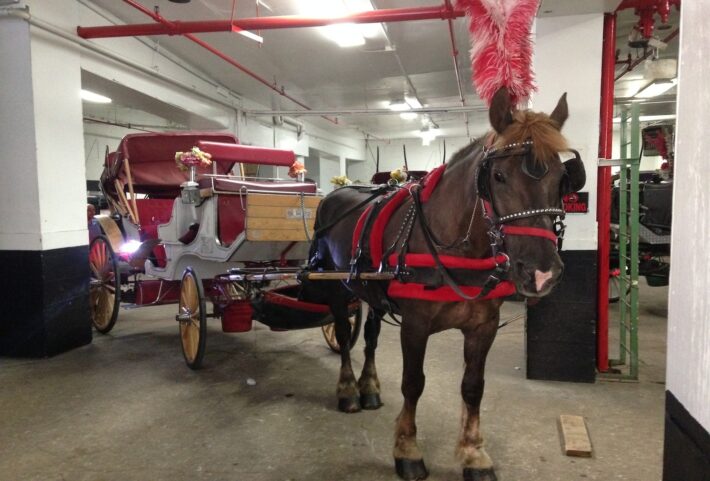
Scientists from Western University in Pomona, California have partnered with Manhattan’s largest horse carriage stable to see if they can prove that New York’s horses are happiest right where they are – working in Central Park. In the tug-of-war between Mayor Bill de Blasio’s proposed ban on the horse-carriages and industry supporters’ efforts to keep the tradition alive, scientific data amassed in early August at Clinton Park Stables will provide information on whether the practice is inhumane and cruel.
Professor of Equine Medicine Joe Bertone said the testing identifies levels of wellness and stress in horses living at Clinton Park Stables on 52nd street. “Our goal is to identify where the horses are, and what health and general stress levels they are at,” said Bertone, who collected samples in New York before returning to Pomona to conduct the study. According to Bertone, three parameters define the horses’ condition: levels of cortisol (the stress hormone) in saliva and feces, and eye temperature. Approximately 20 out of 78 working horses at Clinton Park were tested for the study, the results of which are anticipated in December.
Dr. Linda Mittel, an independent equine veterinarian and a senior extension associate at Cornell University’s Animal Health Diagnostic Center, said that although Cornell doesn’t routinely run these tests, “a scan of the literature shows that it has been reported and has been used in determining stress in some areas in the horse, the fecal cortisol in particular.”
While Western University and the Horse and Carriage Association are co-funding the study, which costs approximately $10,000, Bertone said that the Carriage Association had no influence over its design. If results show that the horses are unwell, Bertone said, “that would be a benchmark to install improvements in the stables.” Conor McHugh, the stable manager and one of 15 owners of Clinton Park Stables, said he feels “confident that won’t be the case.”
Elizabeth Forel, president of the Coalition to Ban Horse Drawn Carriages, disagrees. “This is like the dairy industry promoting milk even though there is so much evidence why it is bad for you,” she wrote in an email. NYCLASS, New Yorkers for Clean, Livable and Safe Streets, the horse-carriage industry’s largest opponent, declined to comment on whether the organization had ever conducted a study of its own. Their email response read: “The thousands of NYCLASS supporters in New York appreciate the mayor’s consistent support for ending the unsafe and inhumane carriage horse industry.” The Mayor’s press office provided this response: “We’re considering a range of options that move the horses off our streets, safeguard the animals, and protect the livelihoods of the men and women who provide carriage rides.”
Eight months into his term, Mayor de Blasio has yet to introduce legislation regarding the ban, which he promoted aggressively throughout his campaign and upon entering office. Christina Hansen, a horse-carriage driver for six years, said, “they’re further away from banning us than they were a year ago.” She credits growing support from the local public in New York. A June Quinnipiac University poll found that 66 percent of city voters said de Blasio shouldn’t ban horse-drawn carriages. Last month, the Working Families Party — an influential political party that previously supported de Blasio — switched sides, citing the protection of middle class jobs and the pivotal role played by the horse-carriage industry in generating millions of dollars in revenue as one of the top three tourist attractions in the city.
According to Cornelius Byrne, owner of Central Park Carriages, a 17-horse stable on 37th Street, real estate is the driving force behind the ban. Byrne said that NYCLASS founder, Steve Nislick, former CEO of Edison Properties, is more interested in developing land than in saving the horses, but Allie Feldman, Executive Director of NYCLASS, dismissed the idea in an interview with USA Today last January. “Steve has been a philanthropist for animal rights for many years. To suggest he has any motive other than the safety and welfare of these animals is beyond ludicrous,” she said.
With local construction booming, the proposed ban has drawn attention to the development potential of the stables. “It all depends on zoning,” said Joe Koicim, an investment sales broker at Marcus & Millichap. “However, the best use of these properties would be for high-end residential condominiums and/or a hotel.”
Byrne, who has owned his stable for 35 years, said the horse-carriage industry has a future in New York even if it means relocating the stables elsewhere.